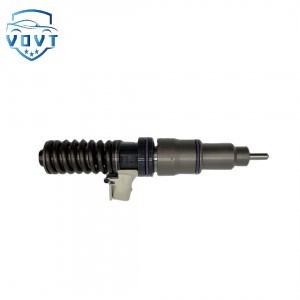New High Quality Diesel Nozzle LP004B for Injection Nozzle Diesel Engine Parts
Products Description
| Reference. Codes | LP004B |
| Application | / |
| MOQ | 12PCS |
| Certification | ISO9001 |
| Place of Origin | China |
| Packaging | Neutral packing |
| Quality Control | 100% tested before shipment |
| Lead time | 7~15 working days |
| Payment | T/T, L/C, Paypal, Western Union, MoneyGram or as your requirement |
How does the common rail system achieve precise control of fuel pressure?
Closed-loop control architecture: pressure feedback and target tracking
The common rail system uses a closed-loop control loop of pressure sensor - ECU - actuator to dynamically adjust the pressure in real time:
Pressure sensing
A high-precision pressure sensor (accuracy ±1% FS) is installed on the common rail pipe to monitor the rail pressure in real time at a frequency of more than 10kHz. For example, in the Bosch system, the sensor signal is processed by the internal amplifier circuit and output to the ECU linearly at 0.5V (key on) to 4.5V (200MPa).
Target pressure decision
The ECU generates the target pressure by looking up the table according to the engine operating conditions (speed, load, water temperature, etc.):
Cold start: The rail pressure is increased by 20%-30% (such as from 100MPa to 120MPa) to overcome the effect of increased fuel viscosity on atomization;
Acceleration condition: The target pressure can instantly jump from 100MPa to 180MPa, and the pressure fluctuation caused by injection is compensated in advance through feedforward control.
Actuator adjustment
The ECU controls the oil metering unit (EFC valve) or pump control valve (PCV valve) of the high-pressure pump through a PWM signal:
In the Bosch system, the EFC valve is in the maximum oil supply state when the power is off. After the power is on, the effective stroke of the plunger is adjusted by the duty cycle to achieve 0-100% adjustment of the oil supply;
The PCV valve of the Denso system adopts the "power on oil supply, power off oil cut" logic, and controls the average oil supply through the pulse frequency.
Key component coordination: dynamic balance of high-pressure pump and common rail pipe
Precise regulation of high-pressure pump
The three-plunger radial pump (such as the Bosch CP3 series) is driven by the camshaft, with 3 oil supply pulses per revolution, and the single oil supply can be accurately controlled to ±0.5mm³. For example, when the rail pressure is lower than the target value, the ECU closes the PCV valve in advance, extends the plunger oil supply stroke, and increases the single oil supply by 20%-30%.
Optimization of high-pressure pump drive torque: adopting asymmetric cam profile design, the peak torque is reduced to 1/3 of the traditional inline pump, reducing engine power consumption.
Pressure stabilization mechanism of common rail pipe
The volume design of common rail pipe (usually 20-50cm³) needs to balance pressure fluctuation suppression and response speed: too large volume leads to delayed pressure response (such as 200ms from 100MPa to 200MPa), and too small volume cannot absorb high-pressure pump pulse (fluctuation exceeds 5MPa).
Mechanical redundancy protection: the pressure limiting valve (such as Bosch system set 150MPa) physically releases pressure when electronic control fails to prevent pipeline bursting.
Dynamic optimization strategy: multi-dimensional compensation and adaptive control
Pressure fluctuation suppression technology
Feedforward control: predict the injection time and injection amount, and increase the fuel supply of the high-pressure pump in advance. For example, under certain working conditions, a single injection causes the rail pressure to drop by 15MPa. The ECU uses the feedforward algorithm to increase the fuel supply by 15% 0.5ms before injection.
Pulse attenuation design: The inner wall of the common rail pipe adopts a damping coating (such as ceramic coating) to attenuate the high-pressure pump fuel supply pulse (peak value up to 250MPa) to within ±2%.
Injector consistency compensation
For the flow deviation caused by injector wear, the ECU dynamically adjusts the power-on time by monitoring the rail pressure drop value:
Monitor the rail pressure drop value ΔP after injection. If the actual ΔP is 10% greater than the standard value, the next injection power-on time is shortened by 5%;
In one case, the algorithm reduces the injection amount deviation of each cylinder from ±8% to ±2%.
Application of advanced control algorithms
Fuzzy PID control: Under dynamic conditions such as rapid acceleration, fuzzy logic automatically adjusts PID parameters based on error (e) and error change rate (Δe):
When | e|>10MPa, increase the proportional coefficient (Kp from 0.8 to 1.2) to quickly approach the target pressure;
When Δe<5MPa/s, increase the integral coefficient (Ki from 0.05 to 0.1) to eliminate steady-state errors.
Multi-objective optimization: Under the stringent National VI emission standards, the ECU needs to balance NOx and particulate matter (PM) emissions in pressure control, such as controlling rail pressure fluctuations to ±3% through segmented injection (pre-injection + main injection + post-injection) while reducing PM by 40%.





















